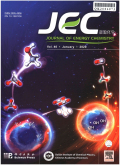- 钛学术文献服务平台 \
- 学术期刊 \
- 工业技术期刊 \
- 石油与天然气工业期刊 \
- 能源化学期刊 \
In-situ construction of conducting alloy interphase towards modulating Li-ion storage kinetics
In-situ construction of conducting alloy interphase towards modulating Li-ion storage kinetics
基本信息来源于合作网站,原文需代理用户跳转至来源网站获取
摘要:
Interface engineering strategy shows great promise in promoting the reaction kinetic and cycling performance in the field of electrochemical energy storage application.In this work,an in-situ interface growth strategy is proposed to introduce a robust and conducting MoGe2 alloy interphase between the electrochemical active Ge nanoparticle and flexible MoS2 nanosheets to modulate their Li-ion storage kinetics.The structural evolution processes of the Ge@MoGe2@MoS2 composite are unraveled,during which the initially-generated Ge metals serve as a crucial reduction mediator in the formation of MoGe2 species bridging the Ge and MoS2.The as-generated MoGe2 interface,chemically bonding with both Ge and MoS2,possesses multi-fold merits,including the maintaining stable framework of electrochemically inactive Mo matrix to buffer the strain-stress effect and the "welding spot" effects to facilitate the efficient Li+/e-conduction.As well,the introduction of MoGe2 interface leads to a unique sequential lithiation/ de-lithiation process,namely in the order of the electrochemically active MoS2-MoGe2-Ge during lithiation and vice versa,during which the electrode strain could be more effectively released.Benefited from the robust and rigid MoGe2 interface,the delicately designed Ge@MoGe2@MoS2 composite exhibits an improved charge/discharge performances (866.7 mAh g-1 at 5.0 A g-1 and 838.5 mAh g-1 after 400 cycles) while showing a high tap density of 1.23 g cm-3.The as-proposed in-situ interface growth strategy paves a new avenue for designing novel high-performance electrochemical energy storage materials.

推荐文章
Genesis and soil environmental implications of intact in-situ rhizoliths in dunes of the Badain Jara
Rhizoliths
Calcification
Leptic regosols
Artemisia roots
Decomposition
Soil moisture
Li-ion电池的激光焊接
Li-ion电池
激光焊接
铝合金
不锈钢
Re-Os dating of molybdenite and in-situ Pb isotopes of sulfides from the Lamo Zn-Cu deposit in the D
Molybdenite Re-Os dating
In-situ lead isotopes
Skarn deposit
Dachang
In-situ方法在研究退化土壤氮库时空变化中的应用
原状土
就地培养
氮库动态变化
矿质化
土壤退化
内容分析
关键词云
关键词热度
相关文献总数
(/次)
(/年)
引文网络
引文网络
二级参考文献 (0)
共引文献 (0)
参考文献 (0)
节点文献
引证文献 (0)
同被引文献 (0)
二级引证文献 (0)
2021(0)
- 参考文献(0)
- 二级参考文献(0)
- 引证文献(0)
- 二级引证文献(0)
引文网络交叉学科
相关学者/机构
期刊影响力
能源化学
主办单位:
中国科学院大连化学物理研究所
中国科学院成都有机化学研究所
出版周期:
双月刊
ISSN:
2095-4956
CN:
10-1287/O6
开本:
出版地:
大连市中山路457号
邮发代号:
创刊时间:
语种:
eng
出版文献量(篇)
2804
总下载数(次)
0
总被引数(次)
7996
期刊文献
相关文献
推荐文献
- 期刊分类
- 期刊(年)
- 期刊(期)
- 期刊推荐
一般工业技术
交通运输
军事科技
冶金工业
动力工程
化学工业
原子能技术
大学学报
建筑科学
无线电电子学与电信技术
机械与仪表工业
水利工程
环境科学与安全科学
电工技术
石油与天然气工业
矿业工程
自动化技术与计算机技术
航空航天
轻工业与手工业
金属学与金属工艺
能源化学2022
能源化学2021
能源化学2020
能源化学2019
能源化学2018
能源化学2017
能源化学2016
能源化学2015
能源化学2014
能源化学2013
能源化学2012
能源化学2011
能源化学2010
能源化学2009
能源化学2008
能源化学2007
能源化学2006
能源化学2005
能源化学2004
能源化学2003
能源化学2002
能源化学2001
能源化学2021年第9期
能源化学2021年第8期
能源化学2021年第7期
能源化学2021年第6期
能源化学2021年第5期
能源化学2021年第4期
能源化学2021年第3期
能源化学2021年第2期
能源化学2021年第12期
能源化学2021年第1期

 免费查重
免费查重










